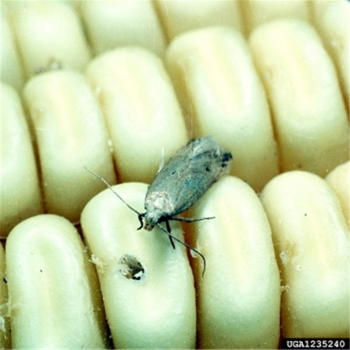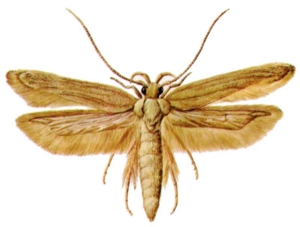Insect Pests of Stored Grain: Angoumois Grain Moth
ENTFACT-156: Insect Pests of Stored Grain: Angoumois Grain Moth | Download PDF
Doug Johnson, Extension Entomologist
University of Kentucky College of Agriculture, Food and Environment

The Angoumois grain moth (AGM) can cause significant loss of crib-stored ear corn held for more than one year. This insect is a primary stored grain pest because its immature (caterpillar) stages develop entirely within a grain kernel. While AGM can attack several grains, it is most often associated with ear corn and is rare in shelled corn. An infested kernel is mostly hollow with a round hole through which the moth emerges. It will weigh about 20% less than a sound kernel. AGM-infested grain usually has an unpleasant odor so animals may refuse to eat it or limit their consumption.
The exit holes in AGM-infested kernels are similar to those produced by grain weevils so finding adults is one way to identify the cause. Adult AGM are small (1/2 inch wing spread), tan to grey moths with fringed wings and the forward portion of the hind wings have distinctive fingerlike tips; adults do not feed. Grain weevils are dark brown beetles with prominent snouts. Weevils and AGM can develop in both ear corn and shelled kernels. AGM and saw-toothed grain beetle can coexist, but maize weevil or lesser grain borer will suppress AGM population.
Like most stored grain insects, AGM infestations can begin from adults emerging from small amounts of carry-over corn in a crib. However, infestations can also begin in the field from moths laying eggs before harvest. The shuck provides protection against this insect. Nevertheless, moths can lay their eggs on kernels exposed due to a loose or damaged shuck.
Life Cycle
AGM moths lay their eggs in the gaps between kernels. Upon hatching, the tiny caterpillars immediately bore into a grain kernel, covering the hole after they enter. These larvae go through three molts will feeding on the interior of the kernel. Just before pupating, the mature caterpillar chews a circular hole leaving a thin film over the future exit, through which the adult moth emerges.
The length of this life cycle depends on temperature with completion in 30 days at 86o F and 40 days at 77o F. Minimum temperature and relative humidity for development is 61o F/30% Rh while the optimum is 86o F/75%/ Rh and the maximum is 95o F. Generally, AGM will have four to five generations per year with the larvae being dormant in the coldest winter months; but may have as many as 10-12 generations in heated warehouses.
Management
Prevention: The techniques listed below should reduce the chance of an infestation and if insecticides have to be employed they will have a better result.
- AGM is the only stored product insect known to infest standing grain in the field. Data suggest that infestation is reduced if grain moisture is greater than 30%. However, storage at this high level of moisture can result in many other problems, like fungal growth. Below that level the pest prefers damp grain in preference to very dry grain.
- Carry-over grain can be a major source of AGM and other stored grain insect pests. It should be removed and discarded (sold, fed, buried, or spread on open ground in winter) to prevent the emerging adult moths from flying back to re-infest the newly stored grain. If leftover grain must be retained, it should be properly fumigated. This is, without question, the technique of last resort. Proper fumigation is costly, dangerous, and requires considerable equipment, supplies, and knowledge along with substantial paper work and notification.
- Removal of all spilled grain from in and around the storage area is an important method of reducing the infesting population.
- All equipment used to harvest, move, and store the grain should be thoroughly cleaned well before these events occur.
- If possible shell the corn from the cob and store in a covered solid sided facility through which air may pass. This will limit AGM infestation to the uncovered grain surface.
- Storage of ear or shelled corn in a solid sided facility through which air may be moved will allow for drying of the grain, thus reducing the chance of mold and limiting the ability of AGM to infest the kernels.
Detection: AGM moths may be monitored by capture in “Delta™” sticky traps baited with a lure containing their sexual attractant. Hang these traps in a space over the stored grain. Count and record the number of moths captured per unit each time. There is no absolute number for use as a threshold. Nevertheless, after a period of use one can estimate how many moths need to be caught to indicate an important population.
Protection in the Crib: Wire, or slatted cribs, or ears piled under open-sided covers may provide some protection from weather but will not protect against insect infestation. There is little one can do aside from the prevention items listed above to control AGM in these structures. One might try to apply a liquid insecticide to the ears, but coverage will be very inefficient. Some AGM moths will be killed but it is unlikely that coverage will be thorough enough to prevent infestation.
Protection in the Bin (solid wall steel or concrete): Infestation of shelled corn stored in sound standard steel or concrete bins is much less likely than on the ear in a crib. However, it may occur, especially in the second and subsequent years of storage. Generally, this begins on the top surface of the grain mass and is somewhat self-limiting. The delicate moths cannot penetrate deeper than the top few inches of shelled grain. However, if storage managers are not vigilant, an accumulation of destroyed kernels, dead insects and excrement can result in a “crust” over the grain. This will reduce air flow and can result in spoiled grain below the surface. Applying a “cap-out” treatment of an approved insecticide product worked into the top 4” inches of the grain and deploying “pest strips” AKA “shield strips” hung in a void over the grain are helpful in controlling this pest.
Remediation: Control of existing infestations in either a crib or bin is possible through fumigation. However, the two situations have different obstacles. Typical on-farm metal grain bins will be less complicated to seal. Wire or slatted cribs would have to be completely enclosed in an impermeable material like 4-mil plastic. The object in both cases is to prevent any of the fumigant gas from escaping. Fumigation kills by holding a specific concentration of poison gas in a given volume of space for a specific amount of time at a specific temperature. Think of inflating a balloon. If the air escapes, the balloon deflates. When fumigating, if the gas escapes, insect control will not occur or occur at a reduced level. Spraying infested ears with a liquid insecticide is unlikely to provide desirable results.
Insecticides: Insecticides for use against AGM and other stored grain insects may be found in the appropriate ENT- publication listed in the References below.
References:
- Back, E. 1920. Angoumois Grain Moth. Farmers Bulletin 1156. USDA.
- Jacobs, Sr., S. and D. Calvin. 1990. Angoumois Grain Moth. SG-1. PSU-CES. http://ento.psu.edu/extension/factsheets/pdf/anggrainmoth.pdf
- Johnson, D. n.d. Insect Pests of Stored Grain: Indian meal Moth. Entfact-136.http://www2.ca.uky.edu/entomology/entfacts/entfactpdf/ef136.pdf
- Johnson, D. ENT-16. Insecticide Recommendations for Field Corn. http://pest.ca.uky.edu/EXT/Recs/ENT16-Field%20corn.pdf
- Johnson, D. ENT-24. Insecticide Recommendations for Grain Sorghum (Milo) http://pest.ca.uky.edu/EXT/Recs/ENT24-Sorghum.pdf
- Johnson, D. ENT-47. Insecticide Recommendations for Small Grains. http://pest.ca.uky.edu/EXT/Recs/ENT47-SmallGrain.pdf
- Johnson, D. ENT-62. Insecticide Recommendations for Popcorn. http://pest.ca.uky.edu/EXT/Recs/ENT62-Popcorn.pdf
- Mason, L. 2010. Angoumois Grain Moth. Purdue Extension, E-236-W http://extension.entm.purdue.edu/publications/E-236.pdf
- Weston, P., R. Barney and J. Sedlacek. 1993. Planting Date Influences Preharvest Infestation of Dent Corn by Angoumois Grain Moth (Lepidoptera: Gelechiidae). J. Econ. Entomol. 86(1):174-180.
Issued: 8/14
CAUTION! Pesticide recommendations in this publication are registered for use in Kentucky, USA ONLY! The use of some products may not be legal in your state or country. Please check with your local county agent or regulatory official before using any pesticide mentioned in this publication.
Of course, ALWAYS READ AND FOLLOW LABEL DIRECTIONS FOR SAFE USE OF ANY PESTICIDE!
Images: Corn with emergence hole, University of Georgia. Adult Angoumois moth, Federal Grain Inspection Service.

